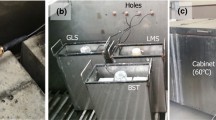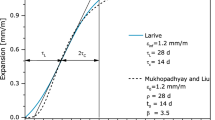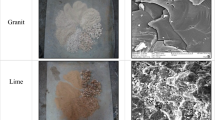Abstract
This paper presents a study that used ultrasonic techniques to nondestructively evaluate (NDE) the damage induced by alkali-silica reaction (ASR) in concrete. The study was conducted on concrete prism samples that contained reactive aggregates and were subjected to different ASR conditioning. The ultrasonic NDE techniques used in the study included measuring wave speed, attenuation and the amplitude of mixed wave in order to accurately calculate the acoustic nonlinearity parameter. Results of the study show that ASR damage reduces wave speed and increases the wave attenuation in concrete. However, neither wave speed nor attenuation is sensitive enough to ASR damage to be considered a good measure for the quantitative NDE of ASR damage in concrete. The acoustic nonlinearity parameter, on the other hand, shows a greater sensitivity to ASR damage, and can thus be used to nondestructively track ASR damage in concrete. However, due to the significant attenuation caused by ASR induced microcracks and scattering by the aggregates, attenuation measurements also need to be conducted in order to accurately measure the acoustic nonlinearity parameter. Finally, destructive tests were conducted to measure the compressive strength of the concrete prisms subjected to different ASR conditioning. It is found that the measured acoustic nonlinearity parameter is well-correlated with the reduction of the compressive strength induced by ASR damage.












Similar content being viewed by others
References
Glasser LD, Kataoka N (1981) The chemistry of ‘alkali-aggregate’reaction. Cem Concr Res 11:1–9
Saouma V, Perotti L (2006) Constitutive model for alkali-aggregate reactions. ACI Mater J 103:194
Smaoui N, Bissonnette B, Bérubé M, Fournier B (2007) Stresses induced by alkali-silica reactivity in prototypes of reinforced concrete columns incorporating various types of reactive aggregates. Can J Civ Eng 34:1554–1566
Bungey J (1997) Ultrasonic testing to identify alkali-silica reaction in concrete. NDT and E Int 4:263
Hobbs D (1986) Deleterious expansion of concrete due to alkali-silica reaction: influence of PFA and slag. Mag Concr Res 38:191–205
Nogueira CL, Willam KJ (2001) Ultrasonic testing of damage in concrete under uniaxial compression. ACI Mater J 98:265
Rivard P, Saint-Pierre F (2009) Assessing alkali-silica reaction damage to concrete with non-destructive methods: from the lab to the field. Constr Build Mater 23:902–909
Saint-Pierre F, Rivard P, Ballivy G (2007) Measurement of alkali–silica reaction progression by ultrasonic waves attenuation. Cem Concr Res 37:948–956
Warnemuende K, Wu H-C (2004) Actively modulated acoustic nondestructive evaluation of concrete. Cem Concr Res 34:563–570
Cantrell JH (2004) Substructural organization, dislocation plasticity and harmonic generation in cyclically stressed wavy slip metals. Proc R Soc Lond Ser A: Math Phys Eng Sci 460:757–780
Herrmann J, Kim J-Y, Jacobs LJ, Qu J, Littles JW, Savage MF (2006) Assessment of material damage in a nickel-base superalloy using nonlinear Rayleigh surface waves. J Appl Phys 99:124913
Kim J-Y, Jacobs LJ, Qu J, Littles JW (2006) Experimental characterization of fatigue damage in a nickel-base superalloy using nonlinear ultrasonic waves. J Acoust Soc Am 120:1266–1273
Müller MF, Kim J-Y, Qu J, Jacobs LJ (2010) Characteristics of second harmonic generation of Lamb waves in nonlinear elastic plates. J Acoust Soc Am 127:2141–2152
Matlack K, Kim J-Y, Jacobs L, Qu J (2014) Review of second harmonic generation measurement techniques for material state determination in metals. J Nondestr Eval 34:1–23
Nagy PB (1998) Fatigue damage assessment by nonlinear ultrasonic materials characterization. Ultrasonics 36:375–381
Chen J, Jayapalan AR, Kim J-Y, Kurtis KE, Jacobs LJ (2010) Rapid evaluation of alkali–silica reactivity of aggregates using a nonlinear resonance spectroscopy technique. Cem Concr Res 40:914–923
Leśnicki KJ, Kim J-Y, Kurtis KE, Jacobs LJ (2011) Characterization of ASR damage in concrete using nonlinear impact resonance acoustic spectroscopy technique. NDT E Int 44:721–727
Leśnicki KJ, Kim J-Y, Kurtis KE, Jacobs LJ (2013) Assessment of alkali–silica reaction damage through quantification of concrete nonlinearity. Mater Struct 46:497–509
Moradi-Marani F, Kodjo SA, Rivard P, Lamarche C-P (2014) Nonlinear acoustic technique of time shift for evaluation of alkali-silica reaction damage in concrete structures. ACI Mater J 111:581
Payan C, Garnier V, Moysan J, Johnson P (2007) Applying nonlinear resonant ultrasound spectroscopy to improving thermal damage assessment in concrete. J Acoust Soc Am 121:EL125–EL130
Haha MB, Gallucci E, Guidoum A, Scrivener KL (2007) Relation of expansion due to alkali silica reaction to the degree of reaction measured by SEM image analysis. Cem Concr Res 37:1206–1214
Swamy RN, Alasali MM (1988) Engineering properties of concrete affected by alkali-silica reaction. ACI Mater J 85:367–374
Liu M, Tang G, Jacobs LJ, Qu J (2012) Measuring acoustic nonlinearity parameter using collinear wave mixing. J Appl Phys 112:4908. doi:10.1063/1.4739746
Liu M, Tang G, Jacobs LJ, Qu J (2012) A nonlinear wave mixing method for detecting alkali-silica reactivity of aggregates. AIP Conf Proc 1430:1524–1531. doi:10.1063/1.4716396
Cash W, Cai W (2011) Dislocation contribution to acoustic nonlinearity: the effect of orientation-dependent line energy. J Appl Phys 109:014915
Kim J-Y, Qu J, Jacobs L, Littles J, Savage M (2006) Acoustic nonlinearity parameter due to microplasticity. J Nondestr Eval 25:28–36
Novak A, Bentahar M, Tournat V, El Guerjouma R, Simon L (2012) Nonlinear acoustic characterization of micro-damaged materials through higher harmonic resonance analysis. NDT E Int 45:1–8
Hurley DH, Telschow KL, Cottle D (2002) Probing acoustic nonlinearity on lengths scales comparable to material grain dimensions. Ultrasonics 40:617–620
Taylor LH, Rollins FR Jr (1964) Ultrasonic study of three-phonon interactions I. Theory Phys Rev 136:A591
Jones GL, Kobett DR (1963) Interaction of elastic waves in an isotropic solid. J Acoust Soc Am 35:5–10
Rollins FR Jr (1963) Interaction of ultrasonic waves in solid media. Appl Phys Lett 2:147–148
Croxford AJ, Wilcox PD, Drinkwater BW, Nagy PB (2009) The use of non-collinear mixing for nonlinear ultrasonic detection of plasticity and fatigue. J Acoust Soc Am 126:El117–El122
Demcenko A, Akkerman R, Nagy PB, Loendersloot R (2012) Non-collinear wave mixing for non-linear ultrasonic detection of physical ageing in PVC. NDT E Int 49:34–39. doi:10.1016/j.ndteint.2012.03.005
Demcenko A, Koissin V, Korneev VA (2014) Noncollinear wave mixing for measurement of dynamic processes in polymers: physical ageing in thermoplastics and epoxy cure. Ultrasonics 54:684–693. doi:10.1016/j.ultras.2013.09.011
Johnson PA, Shankland TJ (1989) Nonlinear generation of elastic-waves in granite and sandstone—continuous wave and travel time observations. J Geophys Res-Solid Earth Planets 94:17729–17733. doi:10.1029/JB094iB12p17729
Johnson PA, Shankland TJ, Oconnell RJ, Albright JN (1987) Nonlinear generation of elastic-waves in crystalline rock. J Geophys Res-Solid Earth Planets 92:3597–3602. doi:10.1029/JB092iB05p03597
Tang G, Liu M, Jacobs LJ, Qu J (2014) Detecting localized plastic strain by a scanning collinear wave mixing method. J Nondestr Eval 33:196–204. doi:10.1007/s10921-014-0224-1
Chen Z, Tang G, Zhao Y, Jacobs LJ, Qu J (2014) Mixing of collinear plane wave pulses in elastic solids with quadratic nonlinearity. J Acoust Soc Am 136:2389–2404. doi:10.1121/1.4896567
Rose JL (2004) Ultrasonic waves in solid media. Cambridge University Press, Cambridge
Royer D, Dieulesaint E (2000) Elastic waves in solids, vol 1. Springer, Berlin
Kim JY, Qu J, Jacobs LJ, Littles JW, Savage MF (2006) Acoustic nonlinearity parameter due to microplasticity. J Nondestr Eval 25:29–37. doi:10.1007/s10921-006-0004-7
International A (2008) Standard test method for determination of length change of concrete due to alkali-silica reaction, vol ASTM C1293-08b. ASTM International, West Conshohocken. doi:10.1520/C1293-08B
Popovics S, Rose JL, Popovics JS (1990) The behaviour of ultrasonic pulses in concrete. Cem Concr Res 20:259–270. doi:10.1016/0008-8846(90)90079-D
International A (2013) Standard test method for measurement of ultrasonic attenuation coefficients of advanced ceramics by pulse-echo contact technique, vol ASTM C1332-01(2013). ASTM International, West Conshohocken. doi:10.1520/C1332-01R13
Mažeika L, Šliteris R, Vladišauskas A (2010) Measurement of velocity and attenuation for ultrasonic longitudinal waves in the polyethylene samples. Ultrasound 65
Philippidis TP, Aggelis DG (2005) Experimental study of wave dispersion and attenuation in concrete. Ultrasonics 43:584–595. doi:10.1016/j.ultras.2004.12.001
Acknowledgments
This work was supported in part by the US National Science Foundation through CMMI-1363221 and in part by the US Department of Energy’s Nuclear Energy University Program through Standard Research Contracts 00126931 and 00127346.
Author information
Authors and Affiliations
Corresponding author
Rights and permissions
About this article
Cite this article
Ju, T., Achenbach, J.D., Jacobs, L.J. et al. Ultrasonic nondestructive evaluation of alkali–silica reaction damage in concrete prism samples. Mater Struct 50, 60 (2017). https://doi.org/10.1617/s11527-016-0869-6
Received:
Accepted:
Published:
DOI: https://doi.org/10.1617/s11527-016-0869-6




